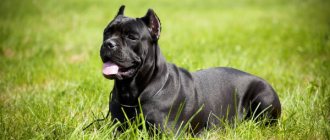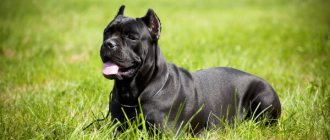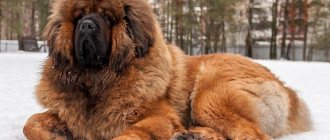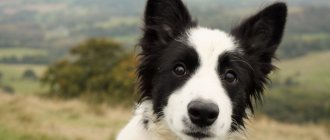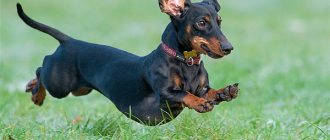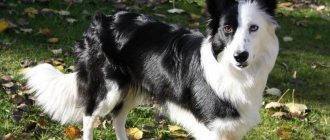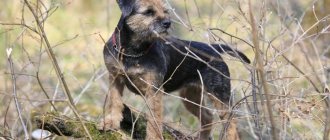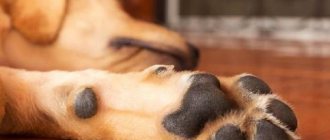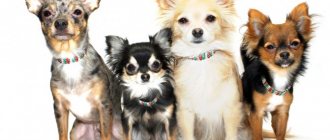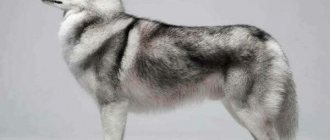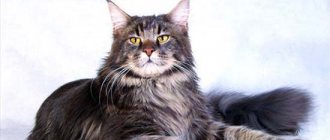- Dogs
| Data from users of the site pets-mf.ru | ||||||||||||
| Age (months) | 1 | 2 | 3 | 4 | 5 | 6 | 7 | 8 | 9 | 10 | 11 | 12 |
| Weight, kg) | — | 4 | — | — | — | — | — | — | — | — | — | — |
| Height (cm) | — | 30 | — | — | — | — | — | — | — | — | — | — |
Some breeders believe that the Border Collie is the smartest dog. There are still discussions about this, but no one doubts that the representatives of the breed are the most obedient. Border Collies are not often seen on the streets, due to the fact that the dog is not recommended to be kept in an apartment. She needs a large enclosure and fresh air.
Description of the Border Collie breed
Popularity 4th among 263 dog breeds
Lifespan:
13-15 years old
Breed group:
Shepherd's
Height:
males: 50-53 cm, females: 47-52 cm
Country of origin:
England
Average price:
25-35 thousand rubles
Weight:
15-20 kg
Latest articles Cat health
Ataxia in cats: what is it, how does it manifest and is treated 01/23/2022 187 0 0
Cat health
Leukemia, or viral leukemia in cats 01/23/2022 162 0 0
Weight of small breed puppies
Small dogs generally grow faster than large dogs, but not as fast as toy breeds. They reach the weight of an adult dog between eight and twelve months.
The Charles Spaniel, French Bulldog, Jack Russell Terrier, Pug and Shetland Sheepdog are prominent representatives of small dog breeds.
In general, this includes breeds that range in size from 5 to 10 kg, but there is some overlap with the size of the dwarf breed.
Small breeds tend to gain weight at a rate of 5-10% per day, which is about 140-220 grams per week. Let's look at the weight of the puppies by month.
Weight of small breeds of puppies by month - table
Use this simple chart to determine how big your little puppy will be. Simply find the weight closest to your puppy's age and move down that column to see the age at 12 months, which is likely to be his adult weight.
Key facts
Surely you have heard more than once that the border collie is considered the smartest dog in the world. And these are not unfounded statements: scientists have tried and proven it scientifically. And the characteristics of the Border Collie breed speak eloquently: you cannot find smarter dogs.
One look at a video or photo of a border collie is enough to understand: this is an ancient herding breed, and “shepherds,” as you know, are distinguished by incredible intelligence. It would be more accurate to use the word “intelligence” - these animals are so smart.
Border Collies are extremely active and active, and tireless work in any social environment is in their blood. Whether it is a family, an emergency team or a herd, the borderer will use his skills to the maximum.
Brief description of the Border Collie breed: super active, freedom-loving, smart people who are very loyal to their owner; They are happy to carry out any instructions, but their strong point is to look after and shepherd.
The health and life expectancy of border collies is encouraging: with a minimum of possible diseases, dogs live on average 15 years.
History of the origin of the border collie
The country of origin of smart shepherds is good old England, the birthplace of many outstanding breeds. To be more precise, the first mentions concern the county of Northumberland.
Peasants kept in their farmstead the ancestors of modern border dogs - English shepherds, who were distinguished by their calm behavior, unpretentiousness in food and care, endurance, kind and easy-going disposition. But their main quality was the ability to herd sheep and even larger livestock: the dogs were excellent at managing the herd and for this they were revered as favorite pets among common people.
Since counts and dukes were not interested in herding skills, the ancestors of Borders remained outside of dog shows and other dog competitions for a very long time. The breed was helped by a lucky chance: it was noticed by Queen Victoria of England. She was amazed by the unusually tenacious and flexible mind of animals, as well as the ability to learn instantly.
The story goes that since then, border collies have become permanent residents of not only the royal palace, but also the homes of all high-ranking officials in England. Interesting fact: despite the love of ordinary people and the nobility, the Border Collie was only recognized as a separate breed in 1915. It was then that its name was fixed.
Until this time, selection was focused on improving collie skills: the best dogs from a herding point of view were selected for breeding. Future Borders were crossed with other collies and even with setters - hence the unusual speckled coloring of some individuals and the relatively long coat.
But at the beginning of the 20th century, the history of the formation of the breed did not end - the standards “wobbled” for a long time and were changeable and inaccurate. Only closer to our time, dog handlers decided on what purebred border dogs should be like.
Appearance of a border collie
General impression
A person who is not knowledgeable about dog breeds may mistake the Border for a simple street dog. This is because this breed does not have any super-outstanding and conspicuous physical advantages. But the expressive and extremely intelligent look reveals a wise dog with roots going back centuries.
Head
The skull is proportional, the muzzle is shaped like a fox. The stop is clearly visible, the dog's nose tapers slightly towards the end. The eyes are harmoniously set, the ears are located closer to the back of the head. Scissor bite, no jowls.
Neck
Muscular, with a slight curve.
Torso
The chest is different in width and depth, convex ribs smoothly transition into the lower back with a slight downward slope. The dog does not have any obvious leanness.
Forelegs
The front legs are parallel to each other and strictly perpendicular to the ground when the dog is in a standing position. The shoulder blades are slightly deflected, but do not connect even when running fast.
Hind limbs
The Border Collie's legs are very strong and muscular. The hock joints are low and laid back. The edge line of the fingers is oval.
Movement
The dog moves smoothly, but quickly. When walking and running, it does not “sag” and stays tucked up.
Tail
It is attached closer to the lower part of the lower back and has a saber shape. The hair on the tail is long and fluffy. The tail may bend slightly towards the end and rise above the back when the dog is highly emotional.
Wool
Regardless of color, the coat can be longer or shorter. The maximum length is noticeable on the frill and trousers, as well as on the tail. The undercoat is soft and dense. The standards do not allow the muzzle and front legs to be covered with long hairs.
Color
Modern border dogs have about twenty types of colors, and all of them are accepted by dog handlers as a standard. The only limitation: white areas should occupy no more than 50% of the entire body. The lilac and merle colors of border collies look especially exotic.
Dimensions
Border collies are medium-sized dogs, their maximum weight (in males, in rare cases) reaches 20 kilograms. The average weight of a Border Collie is 15 kilograms. In this case, girls should reach 47-52 cm at the withers, and boys - 50-53 cm. The maximum height of a border collie is regulated by the standard.
The size of the Border Collie is not impressive, which makes it possible to keep it in an apartment - of course, with frequent and long walks.
Coat type and color
The Border Collie, according to its description established by the standards of international cynology, has two types:
- Smooth-haired;
- Long-haired.
Long-haired animals have a good undercoat; the fur itself is rougher to the touch than the inside. Quite smooth, glossy appearance. Representatives have a beautiful “mane” starting from the head and hardening the neck, on the paws they have a longer “pants” type, the tail in a lowered state resembles the tail of a fox.
The coat looks rich; in color, more than 45% white is not allowed. Usually, there are spots on the chest, paws or a little on the tail. If there is a lot of white color, then the dog is considered a defect and is not allowed for breeding.
Color
- Black (there may be white spots);
- A rich brown, fiery Border Collie with a red color will also have a brown nose color.
- Blue - merle (marble color);
- Brindle (similar to dark, but with three colors of the brindle type), from a distance it appears black and red;
In some colors of Border Collies and their representatives, the main color may be absent, that is, the dog according to the standard should not contain a lot of white hair, but there may be combinations that do not fit the descriptions of the main colors - there is nothing wrong with that.
The wool is odorless and quite easy to care for, both during the shedding period and during everyday life.
The colors of the merle collie are considered very elegant; often their representatives have unpainted eyelids, lips and nose. Blue eye color, or a splash of brown on blue. Shorthaired Borders usually have a predominant tan color and are easier to care for.
Border Collie Personality
The most important thing that a future border collie owner should know is that dogs of this breed require a lot of work. The pet needs constant work, and he will happily endure both routine and frequent changes in activity.
“Border guards” were bred as hard workers, and it was for these qualities that they became loved by many people. Shepherd service is not easy, but the Borders have a craving for it in their blood, and nothing can be done about it. And since nothing can be done, we need to turn it to our advantage.
For example, leave your collie to look after children or other animals - he will happily get down to business. And so zealously that the owner sometimes has to cancel the task so that the dog lets his charges go. If you see that your dog is following you around, you should know that its herding instinct is not fully realized.
Border collies love long walks, hikes, running, and various exercises. Changing places is easy for them, and great physical activity is a joy. It is not possible to keep such animals in an apartment - it is unlikely that the owner will be able to travel 7-10 kilometers with the four-legged animal every day. And for this breed, such mileage is the norm.
The whole world is talking about the border's intelligence. This dog really grasps everything on the fly: what is needed and what is not needed. Useful skills include understanding and executing commands (the collie learns them in one or two minutes), and unhelpful skills include finding loopholes in the character of the owner and family members. Indeed, the borderer knows how to assess people's weaknesses and then skillfully use them to his advantage. So don't fall for his tricks!
Without mental and physical activity, Border Collies become lethargic and may become ill. Therefore, you should not buy a puppy of this breed if you are not sure that you can exercise it a lot. The Border Collie's temperament is almost ideal only when there is physical and mental stress.
Education and training
Border collies learn at lightning speed. It will take very little time to train them to the desired level. But not the strength - the trainer will have to invent little tricks.
For example, herding dogs do not like the monotonous repetition of the same command. If they get bored with something, they will look at the owner, and the look will read “I understand everything, but I don’t want to do this.” So try not just to train your dog, but to give him interesting tasks.
Puppies of this breed are restless, and in order to raise and train a border collie it is necessary to capture their attention. The best way is to show something interesting, to join the game yourself. Then the dogs will enthusiastically pick up your initiative.
Every walk with your pet should turn into an adventure. Take toys from home, find obstacle courses, go hiking, go to water bodies - make your life more diverse with a border collie. Owners who own individuals of this breed note that they have become more toned with the appearance of such an active dog in the house.
You can train a puppy from 3 months, that is, from the moment you start walking him. But the rules of behavior in the house must be learned by the puppy immediately, from the first day: otherwise, you risk causing great material damage. A collie will damage furniture and show character to get attention. This should be nipped in the bud.
Because of their mental and physical abilities, Borders often make excellent service dogs. They participate in searching for people, conducting rescue operations and helping people in other dangerous situations.
Looking for a Border Collie? Find your pet from 23 offers As a gift
Breed traits
Breed traits (on a 5-point scale)
| Border Collie | |||
| Activity | in the house | 3.9 | |
| on the street | 4.7 | ||
| Obedience | training | 4.4 | |
| strangers | 4.1 | ||
| Domination | in family | 2.3 | |
| over dogs | 2.6 | ||
| Defending your territory | from people | 2.3 | |
| from dogs | 2.8 | ||
| Sociability | in family | 4.4 | |
| with strangers | 3.4 | ||
| with dogs | 2.9 | ||
| Concentration | in family | 1.5 | |
| in front of strangers | 2.5 | ||
| with dogs | 2.6 | ||
| Aggressiveness | in family | 1.4 | |
| to strangers | 2.1 | ||
| to the dogs | 2.6 | ||
| to cats | 2.6 | ||
| Family behavior | calmness | 4.6 | |
| demand for affection | 4.1 | ||
| excitability | 4 | ||
| playfulness | 4.4 | ||
| excessive barking | 2.3 | ||
| behavioral breakdowns | 2.4 | ||
| Tolerance for children | up to 4 years | 3.6 | |
| over 4 years old | 3.9 | ||
| Institutional use | watchman | 3.7 | |
| bodyguard | 2 | ||
This breed is often compared to the following dog breeds: Australian Shepherd (Aussie), Sheltie (Shetland Sheepdog), German Shepherd, Golden Retriever, Labrador Retriever.
Border Collie Health and Diseases
Possible diseases
Border Collies enjoy excellent health, mainly due to their mobility. But sometimes it lets them down: dogs have hip dysplasia, which takes a long time to treat.
In addition, borders are prone to blindness, both congenital and acquired in old age. A birth defect can be detected as early as two months of age, so you can protect yourself from purchasing a sick puppy - just buy a dog older than 2.5 months.
As they age, some collies experience retinal atrophy, and the dog's vision declines. In this case, everything must be done to ensure that she continues to lead the most active lifestyle possible.
Reproductive health
Estrus in border girls begins between six months and 14 months, and then occurs every two to three quarters. It lasts approximately 22 days, but it is different for each female: for some it can be up to 30 days.
During the period of heat, you should not give the dog freedom: provide walking only on a leash, and if the dog lives on the territory of a private house, be sure to lock it in an enclosure or keep it at home. Natural instinct encourages the bitch to do the impossible, and even the most obedient dog during estrus can run away and get lost.
The bitch begins to be mated on her third heat, and human assistance is required only if there is an obvious difference in height between the partner dogs. In all other respects, mating proceeds easily.
Pregnancy usually lasts 60 days, but sometimes the bitch can transition a little - up to 70 days. If the dog has not whelped on the 70th day after mating, then it is time to contact a veterinarian.
Safety
It is important to ensure the safety of your home. Given your puppy's curiosity, you should consider possible dangers for him. Dangerous objects that may attract the dog's attention should be removed. First of all, such dangers include electrical wires, which dogs love to chew, as well as sharp objects that are lost on the floor and can be accidentally swallowed by the puppy (pins, buttons).
You should remove plants that are poisonous to animals, household chemicals, plastic film, and foil, which the dog can pull out of the trash can if there are food particles left on them. Chocolate is toxic to dogs, so you should not leave it in the room where your dog can reach it.
If there are stairs in the house, then you should not allow the puppy to move along them. Such exercises negatively affect the formation of joints and the skeleton of a growing organism. It is important to prevent movement on slippery surfaces.
Border collies are very excitable, their attention can be attracted by a sound from the street, a flying bird, after which the dog can jump and fall over the side of the balcony if access to the balcony is free and it is not glazed.
It is important to provide a safe space for your dog to rest. Buy a comfortable bed, bowls and accessories for walking and playing.
Features of feeding and diet
The diet of border dogs should be designed taking into account the fact that the dog is hyperactive. You can choose either dry food or natural food, but in both cases you need to adjust the portion so that the dog does not starve or gain weight.
Dry feeding involves choosing food with a high content of protein-fat complex (about 50% in total). Typically, such foods are labeled “for active dogs.” It is preferable that the composition does not contain soy, as well as wheat and corn - these ingredients do not have the best effect on the collie’s digestion. The main component of collie food is poultry or by-products.
Natural food should include meat and grains, as well as fiber. These are the elements that your pet should receive daily. Meat means red varieties, except fatty pork, offal, sea fish without bones, and poultry. As a “side dish”, cook buckwheat or rice porridge for the dog and season it with a spoon of vegetable oil.
Regarding fiber, it is vital for this breed. What's ideal:
- apples;
- spinach;
- zucchini and pumpkin;
- cabbage (especially broccoli);
- green beans (other legumes are not recommended).
Vegetables are steamed or scalded with boiling water, chopped and served along with meat. It is recommended to give borders kelp, a boiled egg, and a fermented milk product without sugar and salt once a week.
Care and maintenance
As already mentioned, these active pets have no place in the apartment. The ideal option is a spacious enclosure or space on the territory of a private house, where the dog will have the opportunity to run and frolic. If you have other pets or children, don't deprive your collie of the fun to "get" them.
If you really want to have a border collie in your apartment, take him for long walks every day. It is better to choose an area with obstacles or take toys with you. In the summer, you can go to ponds and let the animal swim.
There is one more “minus” in favor of a border in an apartment - heavy seasonal shedding. Get ready to remove wool from everywhere in the fall and spring, and sometimes (due to heating) in the winter. During this difficult period, it is necessary to scratch your collie daily with good combs.
At other times, it is enough to comb the dog once or twice a week and remove any tangles that have arisen. It is not necessary to take your animal to the groomer - only if you will be exhibiting. Bathing often is not recommended - the procedure should be performed a couple of times a month.
Otherwise, the care and maintenance of a border collie is the same as for any other dog: brush your teeth, ears, and wipe your eyes 1-2 times a week. Collie nails usually grind down on their own, but if there are problems, do it once a month or two.
pros
The main characteristics are extremely positive, but there are several important advantages to pay attention to
- Intelligence and training. Enough has been said about collie mental abilities. It follows from this that they are easy to train and quickly master commands.
- Working abilities. You can use Border Collies not only as friends, but also as colleagues. This is true for service people. Another interesting fact is that you can take your dog with you hunting and fishing.
- Possibility of home maintenance. There are breeds that cannot be kept at home. These often include huskies and shepherds. This impossibility is most likely due to the fact that not everyone can adjust the microclimate of the house to the atmosphere of the dog. There will be no problems with a collie! They were bred to help humans, and therefore get along well with people.
- Suitable pet personality. Everyone wants just such a dog - cheerful, loving to run and play. With a border collie you can be like the movies, play fetch with the dog. Also, a trained pet is presented as an advantage over friends and acquaintances - they say, look how my Bobik can do it! He knows both “to me” and “to sit”!
- The average size. To be honest, keeping a large dog in the house is an incredibly difficult task. And keeping a large dog in an apartment is simply unrealistic. It is extremely difficult to provide comfort and at the same time make sure that the pet does not destroy the entire home. It is recommended to keep small or medium-sized dogs in apartments. The Border Collie fits this criterion - the breed is classified as medium.
Tips for choosing a puppy
Regardless of where you go for your future friend - to a nursery or to a private breeder - remember a few golden rules. They will help you choose a healthy puppy without any mixture of other breeds:
- the baby is active, shows interest in everything that happens around him;
- at the same time, the kitten does not have nervousness and timidity - a healthy collie is very brave and curious;
- Border Collie puppies are well-fed, their eyes are sparkling, their ears are clean, and their teeth are straight;
- the mother of the children is calm and healthy (you can ask for a certificate);
- pay attention to the puppy’s vision - he should respond well to movement next to him;
- The place where the bitch and her cubs live should be clean, tidy, and free of unpleasant odors.
If you see a discrepancy in at least one point, it is better to refuse to purchase a puppy in this place. If you are satisfied with everything, but have doubts about the purebred, use the services of a specialist dog handler. For a small amount, he will accompany you and give comprehensive advice.
Before taking your puppy home, be sure to ask the breeder all your questions. Ideally, ask for a phone number to contact for the first time - a conscientious breeder will be happy to do this. If they refuse to give you contact information, this is a reason to seriously think about it.
Ask about feeding, sleep, vaccinations - this is very important. Also make sure that all documents are completed correctly (if you are taking a puppy for breeding or exhibitions). But, if this doesn’t matter, just make sure that the puppy is healthy - because this is the most important thing.
How to choose a puppy
We choose an active, sociable, moderately well-fed animal and refuse lethargic, apathetic puppies with dirty ears and a dry nose. You should first get to know the parents of the future pet, and of course, clarify information about the vaccinations given to the dog. If pedigree and standard appearance are important, it is better to contact well-known nurseries.
In order to save money, you can go through virtual bulletin boards like Avito and buy a border collie puppy “from hand”. Sometimes unscrupulous sellers, under the guise of purebred puppies, sell mongrels of a similar color or mixed breed, so it is better to come to a meeting with the owner of the animal with a specialist who can distinguish a purebred from a pseudo-border.
How much does a border collie cost?
A purebred border dog cannot cost less than 20 thousand rubles. And this price is offered for a puppy with minor defects - this is a pet class, which is not allowed for breeding and exhibitions. “High-quality” breed-class puppies will cost about 40 thousand rubles, and elite representatives of the show class – from 60 thousand rubles and above. Of course, the price of a border collie will depend not only on its qualities, but also on the reputability of the nursery.
Do you like the article? 0

